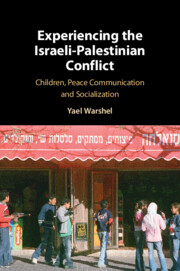Book contents
- Experiencing the Israeli-Palestinian Conflict
- Experiencing the Israeli-Palestinian Conflict
- Copyright page
- Dedication
- Contents
- Figures
- Tables
- Acknowledgments
- Note on the Text
- Abbreviations
- Introduction
- Part I The Encoding and Production of Israeli and Palestinian Sesame Street
- Part II Audience Reception of Israeli and Palestinian Sesame Street
- Introduction to Part II: Audience Reception Methodologies
- 4 Decodings by Palestinians-in-the-Making
- 5 Decodings by Jewish Israelis-in-the-Making
- 6 Decodings by Arab/Palestinian Israelis-in-the-Making
- Conclusion to Part II: The Utility of the Series for All Three Partners to the Conflict?
- Part III Situating the Reception of Israeli and Palestinian Sesame Street in Mundane, Intractable Conflict Zone Practices
- Part IV Conclusions and Recommendations to Improve Peace Communication Research, (Evidence-Based) Practice and Conflict Intractability Interpretation
- Book part
- References
- Index
- Plate Section (PDF Only)
4 - Decodings by Palestinians-in-the-Making
from Part II - Audience Reception of Israeli and Palestinian Sesame Street
Published online by Cambridge University Press: 08 July 2021
- Experiencing the Israeli-Palestinian Conflict
- Experiencing the Israeli-Palestinian Conflict
- Copyright page
- Dedication
- Contents
- Figures
- Tables
- Acknowledgments
- Note on the Text
- Abbreviations
- Introduction
- Part I The Encoding and Production of Israeli and Palestinian Sesame Street
- Part II Audience Reception of Israeli and Palestinian Sesame Street
- Introduction to Part II: Audience Reception Methodologies
- 4 Decodings by Palestinians-in-the-Making
- 5 Decodings by Jewish Israelis-in-the-Making
- 6 Decodings by Arab/Palestinian Israelis-in-the-Making
- Conclusion to Part II: The Utility of the Series for All Three Partners to the Conflict?
- Part III Situating the Reception of Israeli and Palestinian Sesame Street in Mundane, Intractable Conflict Zone Practices
- Part IV Conclusions and Recommendations to Improve Peace Communication Research, (Evidence-Based) Practice and Conflict Intractability Interpretation
- Book part
- References
- Index
- Plate Section (PDF Only)
Summary
Part II describes how the audiences of practice—the stateless nation, or Palestinians, the state-bearing nation, Jewish-Israelis, and the state minority, Arab Palestinian Israelis—decoded the text, as their interpretations related to their respective conflict-resolution outcome goals of justice, security and equality. Chapter 4 outlines how the majority of the stateless nation audience did not “see” Jewish Israeli characters, referring to them as “Jews,” and negatively stereotyped them an “army of infidels.” These Palestinian children actively resisted the text regarding their Jewish Israeli others and did not observe the series’ encoded pro-social relations between Jewish Israelis and Palestinians. Most interpreted those characters to be “Palestinians” or “Arabs,” generalizing their positive attitudes toward all Palestinian and Arab/Palestinian Israeli characters to their wider grouping on screen and off. Cognitive imbalance explains why 20 percent who decoded good-natured “partial Jews” did not generalize them to “Jews”. Sesame Street is unlikely to alter their inter-grouping attitudes toward Jewish Israelis or their policy-relevant political beliefs, even more crucial to managing the region’s ethnopolitical and multi-state conflicts. The majority constructed Arab/Palestinian Israelis as like them but living elsewhere, and held positive to very positive attitudes toward them. But their initial attitudes render this development less important.
Keywords
- Type
- Chapter
- Information
- Experiencing the Israeli-Palestinian ConflictChildren, Peace Communication and Socialization, pp. 151 - 177Publisher: Cambridge University PressPrint publication year: 2021

